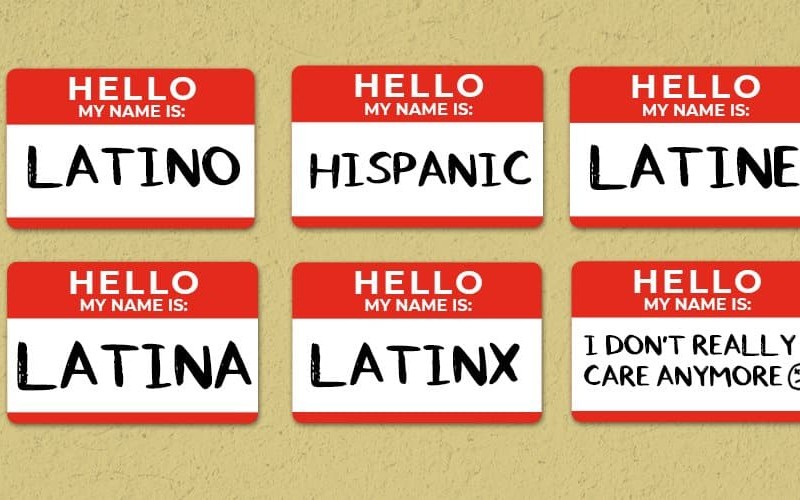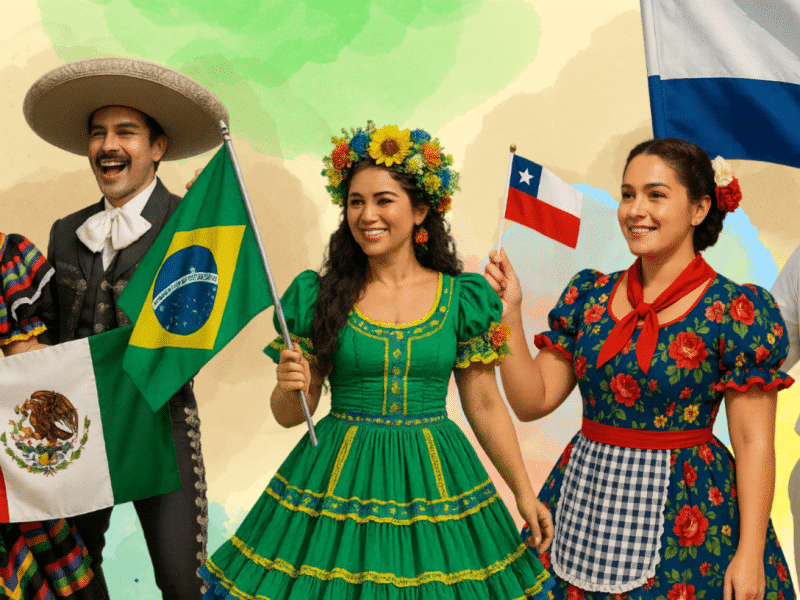What’s in a Name? Hispanic, Latino, and More Explained
Hispanic, Latino, Latine, Latinx…? These labels are ever-changing as people continue to redefine themselves, especially within diverse communities like ours.

Identity labels (which are socially constructed) continually evolve as they shift through generations and as people grapple with predefined categories. As individuals redefine and express themselves, these labels are bound to transform, especially within intricate and often misinterpreted communities like Latinos whose racial backgrounds range from Indigenous to Black to white, to the ever elusive but not formerly recognized, “Brown.”
Latinos represent all races. It’s important to note that Hispanics are considered an ethnic group, which means they share a common language, culture, and heritage, but not a common race.
According to Pew Research Center, a 2019 poll showed that nearly half of Hispanics (47% to be exact) preferred to identify with their family’s home country, while 39% went with “Latino” or “Hispanic,” and a solid 14% just called themselves American. With so many in the Latine community using specific and general labels, how do they choose which ethnic or racial category to tick? (By the way, at Luz Media, we use all these terms freely. We won’t claim to be the final word on this never-ending debate.)
It’s also interesting to note that Hispanic personal identity begins to fade across generations. Pew Research also found that at least 11% of American adults with Hispanic ancestry no longer identify as “Hispanic.” Rather, they report having “Hispanic or Latino” ancestry instead of using a label as their racial or ethnic label. By the 4th generation of U.S.-born Latinos, only about 50% are using the Hispanic or Latino label, and the other 50% identify as non-Hispanic with Hispanic ancestry or heritage.
As if that’s not complicated enough, it should further be noted that there’s been an increase in some U.S.-based Latinos who have reconnected with their Indigenous roots and who decline to acknowledge any Spanish lineage or who instead choose to claim their indigeneity only or partially, whether genetically accurate or not.
As “Hispanic Heritage Month” celebrates the histories, cultures, and contributions of American citizens whose ancestors came from Spain, Mexico, the Caribbean, and Central and South America, it’s important we understand and respect the diverse ways in which each individual chooses to identify. Labels often carry deep personal, historical, and cultural meanings, and it’s a testament to the richness of the community that so many terms exist.
The beauty of identity is that it’s fluid, multifaceted, and deeply personal, and understanding these labels is just the beginning of appreciating our rich heritage.
So, without delving further into the complex topic of race and identity, which could fill an entire Ph.D. curriculum, we’ll focus on the surface-level subject of the identity labels that exist for Latinos, Latine, Hispanic, and whatever you choose to call yourself (and what people who aren’t Latino call us).
What is Hispanic?
This term refers to people who originate from Spanish-speaking countries. It includes Spain but excludes Brazil (where Portuguese is the official language). For instance, the reasoning goes that both someone from Spain and another from Mexico would be considered Hispanic because they both come from Spanish-speaking countries. The term was popularized in the U.S. during the 1970s Census as a way to categorize residents who identified with Spanish culture or origin, irrespective of race.
Many Latinos are weary of this label because it emphasizes the language and European Hispano roots and, in turn, the connection to Spain. For some time, “Hispanic” was the preferred term for those with roots in Spanish-speaking nations in Latin America. However, it has lost favor for what was seen as a more “precise” term for our community, “Latino.”
Hispanic remains as a legacy term, but is highly disfavored in its use to describe people from Latin American countries, rather than Spanish-speaking European countries like Spain.
What is Latino/Latina?
“Latino” (for men) and “Latina” (for women) are terms used predominantly in the U.S. to describe people who hail from Latin America or have ancestry there. This encompasses a large group of countries from Mexico in North America, through Central America, the Caribbean, and down to South America. As mentioned earlier, while Brazilians aren’t usually considered Hispanic (because their official language is Portuguese and many don’t speak Spanish), they are Latino because Brazil is in Latin America.
The term “Latino” gained widespread recognition in 1997 when the Office of Management and Budget included it in government publications. It was also used on the 2000 Census alongside “Hispanic/Latino.” Its purpose was to create a broader umbrella for people with origins from various Latin American countries and a few Caribbean nations.
However, here’s the issue: not everyone traces their roots to post-colonial Latin America. For instance, consider native Mexicans before Spanish colonization, native Mexicans in the U.S. prior to the Mexican-American war, and some Brazilians and other South Americans who don’t identify as Latino. There’s also the gendered language component that many U.S.-based Latinos don’t identify with and argue isn’t inclusive of the non-gender conforming community.
The catch-all term that was supposed to include everyone unfortunately has more gaps than the well-worn chanclas we refuse to part with.
What is Latinx?
“Latinx” is the solution to the gendered Latina and Latino terms that was created as a gender-neutral and inclusive term, mostly adopted among younger generations and LGBTQ+ communities in the U.S. It’s a way to encompass all identities, beyond just male and female, from the Latin American diaspora.
One common argument against the term “Latinx” is that seeks to change the foundational nature of the gendered Spanish language. Spanish language purists can’t accept the fact that a language could be changed in any way, although language is always in flux and changes all the time. It’s worth noting that Spanish was the language of colonizers, and if the genocide of indigenous Latin-Americans had never occurred, many of us who aren’t of Spanish descent might be speaking local native languages and dialects today. So, the “our Spanish is sacred” argument is a tough sell.
That being said, the disdain for this term is fairly widespread. Regardless of validity of critique or not, the vast majority of people simply don’t identify with Latinx. According to the Pew Research Center, 1 in 4 U.S. Hispanics are familiar with the term “Latinx,” but only 3% actually use it. They also report that young Hispanic women are the most likely to use it.
What is Latine?
As the Spanish language continues to evolve for Latinos in the U.S., the gendered language with nouns often ending in “o” for males and “a” for females, created a need for a gender-neutral term. Given that Latinx was so disliked and didn’t work well linguistically, “Latine” emerged as a gender-neutral alternative to Latino/Latina/Latinx. The term has gained traction, especially in recent years, amongst those who seek a term that avoids binary gender distinctions.
Pronounced LAA-TIN-AYE, this term is no stranger to challenges, just like Latinx. However, the term Latine can be smoothly integrated into Spanish pronunciation. So, now we have a gender-neutral term that’s both pronounceable and usable in Spanish.
Latine is the latest addition to the label game and seems to be gaining acceptance among our community. Since it’s easy to say in Spanish, it looks like this term, initially the underdog, might be here to stay.
As an aside, Luz Media has adopted Latine Hispanic Heritage Month as its preferred label for the month.
What is Afro-Latino?
The term “Afro-Latino” is used to describe Latin Americans with African ancestry. Latin America, due to historical factors such as colonization and the transatlantic slave trade, has a significant number of people who identify as both Black or Afro and Latino. This term underscores the importance of recognizing and celebrating the diversity of the larger Latino community.
The term Afro-Latin@/x/e has gained widespread popularity as a response to the historical invisibility and deliberate erasure of Latin-American and Caribbean individuals with African heritage.
For even further clarity, “Black Latinos” is a label that includes Latinos of mixed race or those who don’t identify with the “Afro” descriptor. These terms have risen in prominence as they enable discussions and confront the prevalent issues of anti-blackness and colorism within both our native Latin American countries and the United States.
In particular, the terminology regarding Afro and Black Latinos is evolving rapidly. After being marginalized and discriminated against for so long, the Afro-Latino community is eager to express their experiences and identities. Their voices are vital in the Latino community as a whole, and we wholeheartedly support their efforts to define their identities and shout out their pride in their Afro and Black roots.
What is Chicano?
According to the 2019 U.S. Census Bureau population estimate, among different Hispanic subgroups (that’s their term, not ours), Mexicans were the largest group, making up a significant 61.4 percent. Following the Mexican group, were Puerto Ricans (9.6 percent), Central Americans (9.8 percent), South Americans (6.4 percent), and Cubans (3.9 percent). So, it’s only right that we mention the OG label: Chicano.
Chicano is a term that originated in the United States and describes Americans of Mexican descent. It became popular during the Chicano Movement of the 1960s and 1970s when Mexican-Americans sought to regain control of what was a mostly derogatory term and define their identity in terms of cultural heritage, rather than immigration or class status, or assimilation. It’s a proud declaration of Mexican-American heritage and has political and social connotations tied to civil rights and empowerment.
After the term’s popularity waned a bit, it has recently started gaining momentum with younger generations and popping back up into popular culture through music festivals, art displays, and celebration of Chicano culture more broadly.
What is Mestizo and Mulatto?
The term mestizo means mixed in Spanish and is generally used throughout Latin America to describe people of mixed ancestry with a white European and an indigenous background. Similarly, the term “mulatto” – mulato in Spanish – commonly refers to a mixed-race ancestry that includes white European and black African roots. In 2015 the Pew Research Center reported that Latinos identifying as “mixed race” was on the rise. In the study, respondents were asked if they identify as “mestizo,” “mulatto” or some other mixed-race combination, one-third of U.S. Hispanics said they do.
This tracks with the recent increase in the U.S. Census, where the increase in Hispanics reporting as “multiracial” continues, as it has been since the 2010 Census.
The topic of race and ethnicity for Latinos is as complicated as it sounds, and if we missed anything, it wasn’t on purpose, we promise! The fact of the matter remains that U.S.-based Latinos don’t fit into a single box, and yet, for practicality purposes for media, research, policy-making, and a number of other important reasons, striving for an efficient way to refer to this community is an important endeavor.
No one term is going to be liked by all people. At Luz Media, we always strive to use the terms people identify with first, and a pan-ethnic term second. So, don’t let this article stress you out too much. Remember, at the end of the day, we’re all just trying our best.




